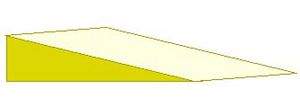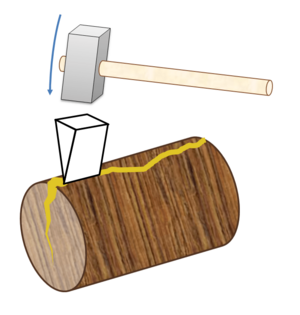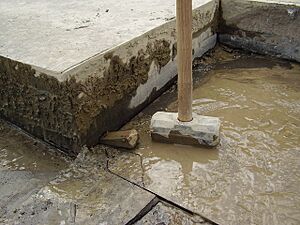Wedge (mechanics) facts for kids
A wedge is a simple machine shaped like a triangle. It is thick at one end and gets thinner to a sharp edge at the other. Wedges are used to push two things apart, like a knife cutting wood. They can also lift heavy objects or hold things firmly in place. The power of a wedge depends on how long and thin it is compared to its thickest part.
Contents
History of Wedges
No one knows exactly when wedges were first used, but they have been around since the Stone Age. That's a very long time ago! Around 3000 BC, in Ancient Egypt, people used bronze wedges to break large blocks of rock for building. They also used wooden wedges that would swell up when wet, helping to split rocks. Some Native American tribes used wedges made from deer antlers to split wood for making canoes, houses, and other wooden items.
How Wedges Are Used
Wedges are super useful for many tasks.
Splitting and Lifting Things
Many tools use the wedge shape to split things. Think of an axe or a splitting maul (a tool for splitting wood). These tools have a wedge-shaped blade that pushes wood apart. Wedges can also lift heavy objects or adjust their height slightly. Small wedges used for this are sometimes called shims. Even everyday items like knives, scissors, chisels, and your own teeth work like wedges when they cut or bite!
Holding Things in Place
Wedges are also great for holding things still. For example, they are used in parts of car engines and bicycles. A common example is a door stop, which is a wedge placed under a door to keep it open. It works by creating friction between the door and the floor.
Even a nail is a type of wedge! When you hammer a nail into wood, its pointed, tapered end acts like a wedge, splitting the wood fibers and holding the nail firmly in place. A bolt, which isn't tapered, won't go into wood the same way.
How Wedges Give You a Mechanical Advantage
A wedge gives you a "mechanical advantage," which means it helps you do work with less effort. The longer and thinner a wedge is, the more mechanical advantage it has. This is because the force you put into the wedge is spread out over a larger area as it pushes things apart.
You can figure out the mechanical advantage (MA) of a wedge using a simple formula:  Here, 'S' is the length of the sloping side of the wedge, and 'T' is the thickness of the wedge at its widest part.
Here, 'S' is the length of the sloping side of the wedge, and 'T' is the thickness of the wedge at its widest part.
So, a wedge with a very sharp, narrow angle will have a greater mechanical advantage. This means it can split things more easily. However, sometimes a wider angle is better. For example, splitting mauls have a wider angle than axes because wood can sometimes get stuck more easily in a very narrow wedge.
Related pages
- Axe
- Inclined plane
- Screw
- Shim
- Splitting maul
- Simple machine
Images for kids
-
Flint hand axe found in Winchester
See also
 In Spanish: Cuña (máquina) para niños
In Spanish: Cuña (máquina) para niños





